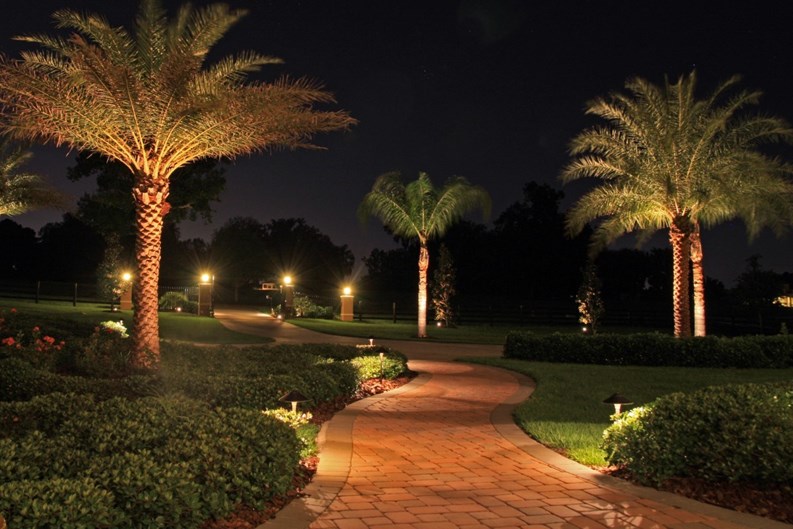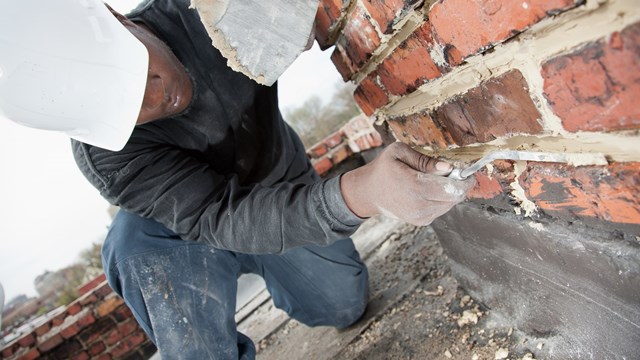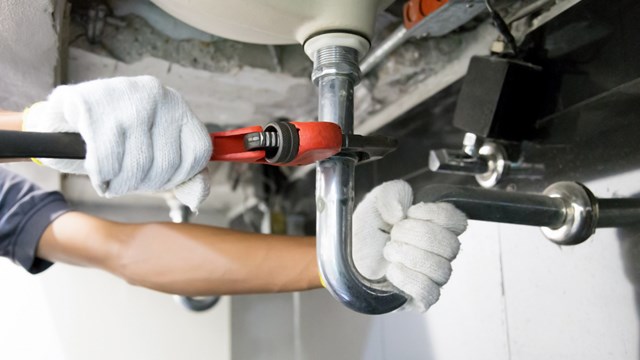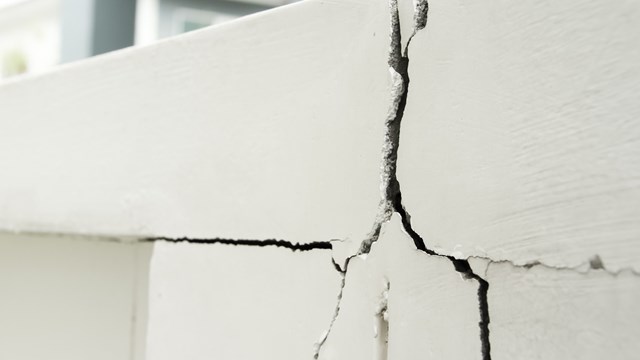As recently as the 1930’s, only 68 percent of American homes had electricity. By the middle of the last century however, most Americans enjoyed well-lighted homes, and the light had started to spread outdoors as well. Initially, yards and gardens were lit purely for visibility and safety, but once decorative lighting became a reality, there was no turning back. Today exterior lighting provides an exciting way to protect, beautify, and showcase properties, both brand-new and historic.
Simply updating exterior lighting can enhance safety and provide renewed curb appeal for most properties. Technology advancements in low voltage, high-efficiency light-emitting diodes (LEDs) make it possible to actually increase lighting while creating dramatic nightscapes that are both functional and more cost effective. Ultra-efficient LEDs are eco-friendly, using only a fraction of the energy required by the mercury vapor lights used for decades. LEDs can save up to 75 percent in operating cost over other light sources, plus additional savings in maintenance costs thanks to their superior longevity.
Throwing Light on History
Lighting can easily set the mood for social and recreational events while extending the hours residents can safely enjoy outdoor areas. This concept was accidentally discovered in 1700 by King Louis XIV in Paris, The City of Light. The Sun King originally set out to beautify the parks, boulevards, and landscaping in and around Paris—but his urban renewal projects became a target for vandals. In response, Louis XIV implemented an elaborate security system that included 7,000 street lights.
The first reported widespread use of outdoor lights was to prevent property damage, and it worked extraordinarily well—with an interesting twist. King Louis’ innovation created an attractive environment for the city’s inhabitants. Instead of going home or to bed when the sun went down, the residents of Paris took to the streets and developed a nighttime social culture that included new industries and businesses. The classic Parisian street scene of bustling cafes, lively taverns, and chic night-spots would never have been possible had Louis not lit up the evening to protect his projects.
From Lamplight to Lightscaping
Lighting made the difference then and now. It is easy to imagine most condominium residents will be encouraged to enjoy their common areas—indeed, the entire property—more in the evenings when paths, decks, and recreation areas are attractively and safely lighted. Unique architecture, fountains, arbors, trellises, and water features are particularly beautiful when enhanced with lightscaping.
That being said, good outdoor lighting involves more than just a couple of amber-colored spotlights pointed at a tree or hedgerow. Expert advice can help a board decide on the types and applications of outdoor lightning. Over the last couple of decades, a whole new vocabulary has evolved to describe lighting designs and techniques. Uplighting, downlighting, path lighting, specialty lighting, underwater lighting and backlighting are just a few of the terms and choices available in the world of outdoor lighting. Fixtures are available in a vast variety of sizes, colors, materials and styles.
When to Call In the Experts
With the constant advancements in lighting and installation challenges, exterior lighting is not a do-it-yourself project. Whether your HOA has an existing system that was hard-wired at construction or added at a later date must be considered. Some systems may allow integration into a newer expanded lighting system, and some may not. Once a board decision is made to investigate lighting options, it is time to consult with a few reputable companies.
In addition to a licensed, bonded, certified electrician, a board will want a company with experience and expertise in landscape lighting design and installation. Most companies will offer free consultations and a design rendering. It is always prudent for board members or design committee members to view projects a bidding company has completed to get an idea of their aesthetics and to talk with former customers to gauge their satisfaction with the completed work. A board may also want to consider moving forward in stages depending on budget constraints. Safety lighting issues will most likely trump aesthetic lighting flourishes but reviewing the entire property upfront can prevent unpleasant surprises and costly do-overs.
Pre-Planning
Before calling in a landscape lighting professional, board members should prepare a list of questions and expectations in order to achieve the biggest impact for the budget. The upfront sticker price can seem high until the greatly reduced operation and maintenance cost are figured into the return on investment (ROI).
Rick Bequette, owner of Brilliant Nights, a Tampa-based exterior lighting firm, urges clients to work with both sides of the ledger. “Expense is always a concern,” he says. “Value can be intangible and may have to be seen to be believed. Decorative lighting adds an element of ambiance that helps a property stand apart, particularly when the entrance is enhanced and awash in lights.”
On the savings side of the ledger, low voltage and LED lights can save up to 80 percent in energy costs, and those margins are only improving with technology. When the reduced cost of maintenance and replacing bulbs is added in on the savings side it goes a long way towards balancing installation expenses. “Installation cost will vary,” explains Bequette. “If the property has line voltage installed at construction, conversion to low voltage may be initially expensive. Savings in energy and maintenance cost will balance out the investment cost.
Another opportunity to save on installation is with quality fixtures. In the 20-plus years Bequette has been in the industry, “Lightscaping cost has changed dramatically.” Aluminum fixtures were often used in the past because they are inexpensive and readily available but aluminum does not weather well in Florida’s climate and replacement costs can add up. Quality fixtures in brass, bronze, and copper have always been available but now Bequette says that these fixtures are available at reasonable pricing, and many carry a lifetime warranty. Since aluminum has a defined life span, quality fixtures may be the better investment.
When a board works with a professional, these issues can be fully discussed and voted on prior to any buying decision. Bequette states that many boards have done their homework before he is called, and the decision is often a “done deal.” The two major reasons he is consulted are energy savings and when crime is a catalyst.
Living in Light
Kim Levell of Levell Design based in Tampa, says, “It’s all about looking at the way we’re living inside and then bringing it outside. Adding exterior lighting to any design is the icing on the cake.”
Levell has spent the last decade happily pursing her chosen career in design, and says her firm's major focus is to actualize designs that are not only beautiful and functional but also sustainable. “We also do our best to utilize local plants, craftsmen and resources,” she explains. “I encourage clients to think about decorative lighting up front, rather than as an afterthought.” Eco-friendly “green” LED lighting is the trend she is asked about most often.
Just south of Tampa, in Sarasota, Jim Paulin owns Lumical Technologies Group, Inc., an outdoor lighting company. Paulin has over 35 years experience in the design and installation of landscape lighting systems, and says there isn’t much he hasn’t seen come and go. He remains excited about the excellent lighting solutions he is able to provide with the advanced technology now available. “We customize every plan to [the client's] special tastes, and fine-tune our work at night,” states Paulin. “All installations and maintenance is performed by our own staff, and we use no outside contractors or installers.”
Paulin sees the exterior lighting field as being in a constant state of flux thanks to new sources of lighting entering the marketplace. Lighting is now more energy-efficient and durable with longer life spans and reduced ecological impact. He says that great progress is being made with high brightness LED lighting, fiber optics, halogen lamps, and fluorescent and induction lamps.
Greg Jett of Outdoor Lighting Perspectives echoes his colleagues' sentiments. Aesthetics, safety and green energy are the hot buttons that have kept his phone ringing the last five years. Jett services West Palm Beach to Stuart along Florida’s Treasure/Gold Coast area. He says his firm is often called in to help a property create a “wow factor” to stand out from the other properties lining the coastal area. He recommends a ROI analysis for boards considering upgrades and improvements to outdoor lighting. It often comes down to educating board members on reasonable expectations for a pay back on the initial investment. Retrofitting older properties is less costly than new or reconstruction and the single best way is to upgrade and update an existing property through lighting and landscape alternatives.
With the current opportunities for long range savings, Paulin recommends that HOAs review, redesign and replace existing exterior lighting, particularly properties that include parking illumination for safety. While the ROI may not be instantaneous, he stresses the benefits of reduced maintenance and energy usage as justification as well as improved aesthetics, safety and security. For most landscape/lightscaping designs, Paulin is a fan of LEDs. They take the lead on longevity, and provide the biggest bang for the buck. “Once a LED fixture is installed, the job is done for many years to come,” he says.
Budgets constraints are the reason Paulin hears most often for boards postponing lighting improvements. His parting words of advice for HOAs is a gentle reminder, “quality lighting isn’t cheap and cheap lighting isn’t good.”
Landscaping and ground maintenance is often one of the largest expenses facing an HOA or COA, yet the results go unnoticed 50 percent of the time. When lightscapes are created with well-placed lighting, a property is showcased and the results are almost magic. A properly illuminated landscape increases curb appeal 24/7 and adds real and perceived value to the property.
Anne Childers is a freelance writer and a frequent contributor to The South Florida Cooperator.







Leave a Comment